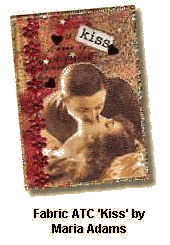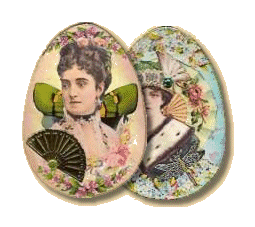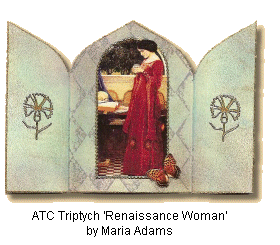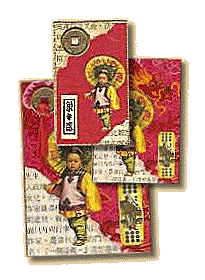How to make Artist Trading Cards
And now for something completely different...
Not completely different perhaps, but to make artist trading cards (ATCs) that are a little bit different from the usual 'standard' trading cards is not difficult. We have a few suggestions for you...
The story so far...
In the first part of our look at how to make artist trading cards we talked briefly about the basics, and about ways to create backgrounds using a variety of materials and techniques. In the second and third parts we went on to look at themes, focal points and embellishments, finishing, storage and display.
Now let's look at ways to make artist trading cards that are that little bit different from the usual.
Amongst the variations we'll be looking at are:
- Doors, Flaps and Pockets
- Fabric Artist Trading Cards
- Unusual shapes for Artist Trading Cards
- Triptychs
- Miniature Artist Trading Cards
Doors, Flaps and Pockets
One way to make artist trading cards that are a little bit different from the usual, and to add extra interest to your designs, is to incorporate elements like doors, flaps and pockets. Doors and flaps can open to reveal hidden secrets, and pockets provide further hiding places for things like altered tags or small found objects and ephemera, such as keys, coins, tickets and photographs.
One of the most unusual examples that we've seen is that of an ATC that features a tiny loom.
You should bear in mind, of course, the requirement of most swap groups that your ATCs are thin enough to fit in a standard trading card sleeve. This means that you will need to choose objects which are not too bulky.

Fabric Artist Trading Cards
Are you a keen textile artist looking for something different? Why not try your hand at making fabric artist trading cards?
In many ways fabric artist trading cards are just the same as any other artist trading cards, and some of the same techniques can be used when you make them. However there are a number of differences, particularly in the way that they are constructed. The most obvious difference is, of course, that they are made mainly from fabric.
Although you can use some of the same techniques when you make fabric artist trading cards, many artists also like to use needleworking techniques such as stitching, quilting and appliqué.
Read more about how to make fabric artist trading cards
Unusual shapes for Artist Trading Cards

Who says ATCs have to be rectangular? Not those enthusiasts who like to make artist trading cards in unusual shapes, like these egg-shaped examples here. Provided the overall dimensions of your cards conform to the standard trading card size of 2½ x 3½ inches (64 x 89 mm) there's no reason not to be adventurous, and try something new.
Clearly egg-shaped ATCs tend to be more popular around Easter time, but for something less seasonal why not make artist trading cards in the simple arched shape that seems to be becoming increasingly popular?
Triptychs
Traditionally, the word triptych was used to mean a work of art consisting of a painting or carving spread across three panels side-by-side, and usually hinged together. It was used in particular to describe an altarpiece made up of a central panel flanked by two smaller hinged panels, each half its width, that could be folded inwards to cover it completely.
It's not difficult to make artist trading cards in the form of a triptych. You will need pieces of cardstock each slightly more than 5 inches x 3½ inches (128 mm x 89 mm), so that when you fold both sides into the middle it ends up as the standard artist trading card size of 2½ x 3½ inches.

Some artists like to shape the top of the card. This example shows a fairly simple arched shape, rather like an old-fashioned church window, but slightly more complicated shapes are also often used.
You will need to decorate all those surfaces that will form the front and inside of your triptych when it is folded. Some artists also like to decorate the back.
You obviously won't be able to use bulky embellishments on the inside, but there's no reason not to use slightly more three-dimensional objects on the front surfaces, provided that the finished artist trading card will still fit in a standard trading card sleeve.

Miniature Artist Trading Cards
Miniature artist trading cards are simply ATCs that are smaller than 'standard' artist trading card size. There appear to be no generally agreed dimensions for these, but the most popular sizes are 1½ x 2½ inches (38 x 64 mm) and 1¾ x 2½ inches (44 x 64 mm). Here are these two commonest sizes compared with a standard artist trading card.
The larger of these two sizes, the same as that of many miniature playing cards, has the advantage of being exactly half the size of a standard artist trading card and much closer to its 5:7 proportions.
For those who prefer to make and swap artist trading cards in the smaller 1½ x 2½ inch format there is a group of enthusiasts, known simply as MiniatureArtistTradingCards, whose members have adopted this as their standard.
Want to know more?
Have you made some ATCs, and would now like to trade with other enthusiasts? Then you'll be interested in our advice on how to swap artist trading cards.
Altered Art Home » Artist Trading Cards » Make Artist Trading Cards


Enjoyed your visit? Why not leave a comment?